Antalya | home
Antalya and the Mediterranean
The call to prayer wakes us at daybreak. Then another mosque chimes in, then another and another. Kaleici is loaded with mosques, all with their loudspeakers turned up full blast.
Our first breakfast in Turkey consists of fresh bread with jam, feta cheese, fresh sliced tomatoes and cucumbers, olives and coffee. Throughout the trip breakfast would be similar. Most places added hard boiled eggs. We came to like our Turkish breakfasts. Servings were generous, the produce usually came from a nearby garden and the coffee was generally pretty good. In fact, after a few days we started to eat only a light snack of fresh fruit at lunch because breakfasts were so hearty.
We spent three nights in Kaleici (Antalya) at the Hotel Urcu. In addition to exploring Kaleici and its beautiful marina/harbor area, we picked up our rental car in Antalya and visited three nearby ruins, Perge, Aspendos and Termessos. Over the course of our drive through western Turkey, we would visit a total of 8 ancient city ruins. Most of them had a similar history. All could trace their roots way back to early Hellenistic (Greek) times, perhaps 700 BC or earlier. In some cases, there is evidence of even earlier habitation. An early milestone for many of these cities was the arrival of Alexander the Great in 334 BC. A couple of hundred years after that, the Roman Empire dominated the area, and from about 100 BC through 300 AD many of these sites became great cities under the Roman mantle. Most of the best preserved ruins are from this Roman era as not too much of the earlier stuff is still around, although we did see a limited amount of Hellenistic stuff in-situ and in museums. The various areas in western Turkey have been conquered by one dominant power or another many times over the past 3,000 years. Some of these conquests resulted in great damage to these sites as cities were sacked, burned and otherwise abused by invading forces. However, some of this stuff is simply so big that it wasn't destroyed. How do you trash chunks of marble that weigh several tons? So in spite of all the abuse, a surprising amount remains to be seen. There has been and continues to be an enormous amount of restoration work at all the sites we visited. Sometimes in is conducted by some University in Austria or somewhere. Most of it these days is done by the Republic of Turkey.
The drill at most of these sites became familiar to us. We would drive up and find the parking lot. Usually someone holding a book of tickets would wander over and collect a parking fee. Most of the larger ruins had an admission booth where we paid another fee to gain entrance. After that, we were on our own to explore. In some cases, particularly in the ruins we visited from our Antalya base, there were perhaps 10 to 25 other people visiting each ruin, all spread out so that often we were alone in a necropolis, bath or other distinct section of an ancient city ruin. There were no fences or apparent restrictions in these places - we had the run of them. Later, as we visited some of the more famous places, most notably Ephesus where cruise ship passengers arrive on shore excursions, more of the ruins structures were fenced off to keep the crowds at bay, and the feel was more touristy. Getting off the beaten path at these higher traffic ruins was not encouraged.
Here are pictures of taken at the three ruins we visited from Antalya. All were within an hours drive of our hotel, although the first time we drove back into town, we had trouble finding our hotel and managed to add some miles by driving around several blocks a bunch of times, all in pretty wild and crazy city traffic.
The first few shots show the ruins at Perge. It was the first ruin we visited and we thought it was pretty neat, although we soon saw some more impressive stuff elsewhere.
|
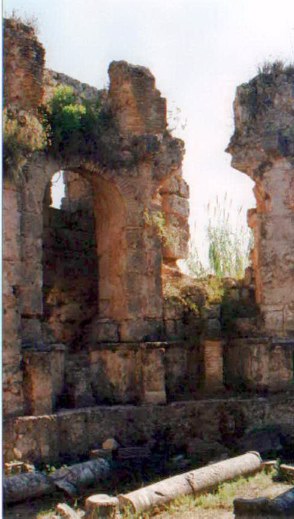 |
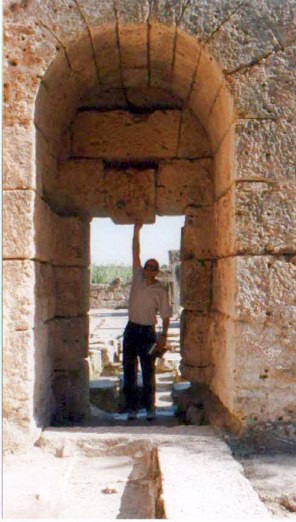 |
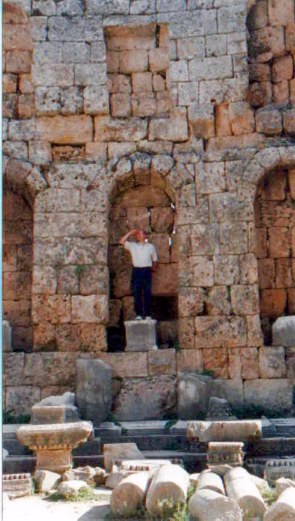 |
Above right: the niches in this wall in Perge once contained marble statues of leading citizens. It looks like one notable remains.
|
||
This is the last shot of Perge - Susie is sitting at the foot of what was once a fountain. In front of her you can see the aqueduct that carried water through the city. This is at the end of a long road that was once lined with columns. The columns are still around, although most of them are in pieces laying along the route.
|
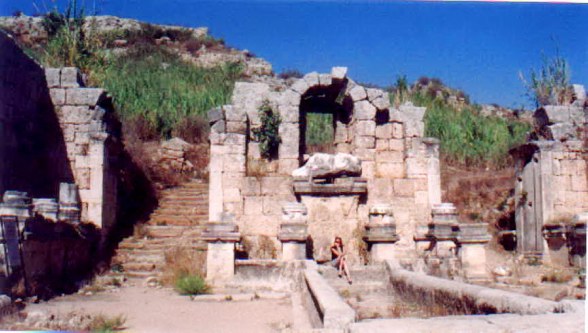 |
The next four pictures are of the theater in Aspendos, another ruin near Antalya. This is the best preserved Roman era theater in the world and is still used today for concerts and other gatherings. It was the first of many interesting theaters we saw, and we appreciated its condition even more after visiting the others.The theater at Aspendos sits at the base of a hill right next to the parking lot. Behind the theater, quite a walk up the hill, lie the remains of the rest of the city. We took the hike up and were rewarded by the quiet 2,000 year-old sentinels at lower right.
|
|
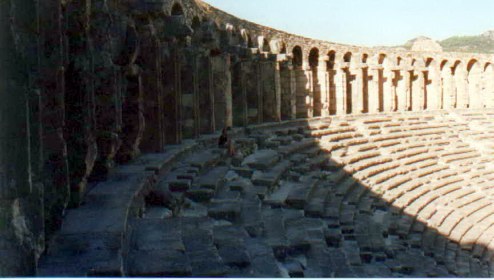 |
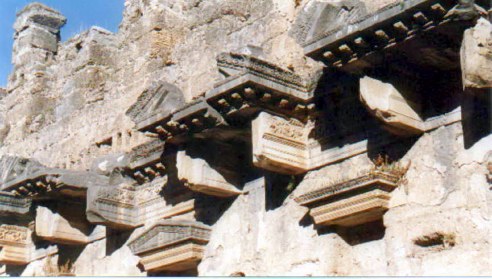 |
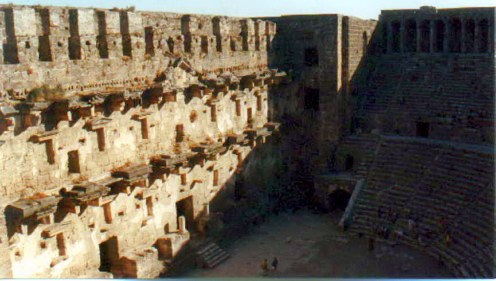 |
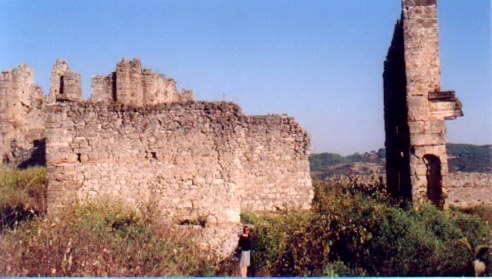 |
The next several pictures were taken at Termessos, again accessed from Antalya and one of our favorite spots. Termessos was a mountain city built in a great strategic position. Alexander tried to take it but eventually gave up. For us modern visitors, Termessos is a little harder to reach than, say, Perge, and once you arrive at the site, most of the ruins are up a pretty steep trail. As a result, Termessos was very uncrowded and there was a lot to see. The views were outstanding. Because of its relative isolation, it has not been as badly pillaged by the various archeologists/museum artifact takers. We also had a perfect day.
This first shot shows rubble just lying around. This was a routine sight. These were big cities with an almost unfathomable amount of cut stone used in their construction. Most of this stone is still there, lots of it just sitting in the weeds. You can see the pillar pieces. The second picture shows Susie wandering around in the same general area. The cut blocks are incredible!
|
|
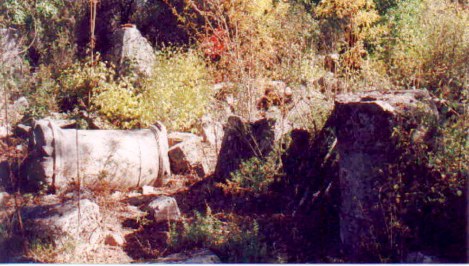 |
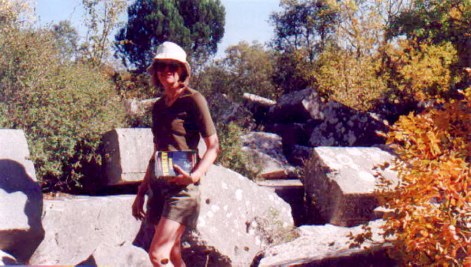 |
You can see that some of this rubble has some inscriptions, and some is very ornate. The ornate stuff was generally from the friezes, horizontal pieces placed on top of columns, like big stone beams or maybe from the pediments, the triangular shaped piece of wall just below a peaked roof.
|
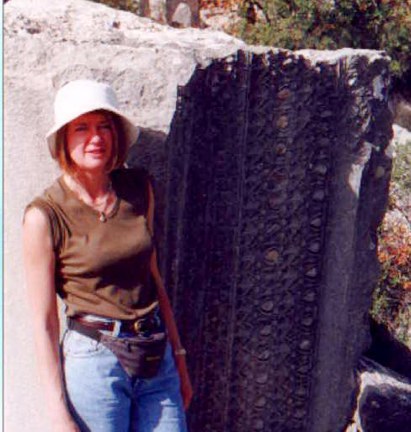 |
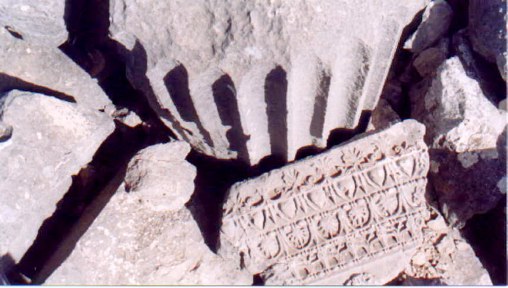 |
|
All of this stuff was in Termessos. Right: I thought this was a particularly interesting spot because the path runs right through the middle of all this stuff, although you can't tell from the picture. It seems a bit profane, but we were using fallen columns for walkways in many locations.
|
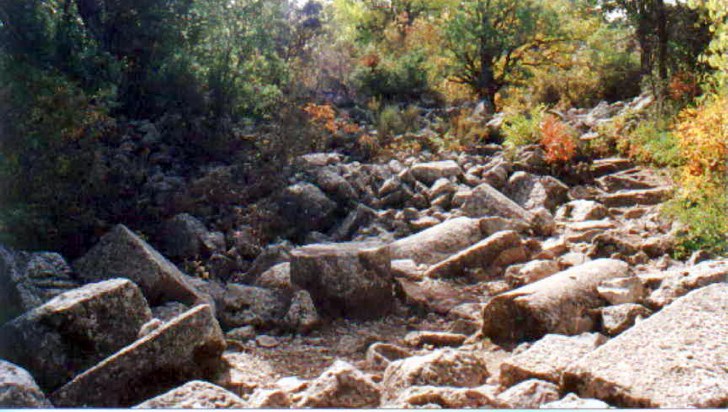 |